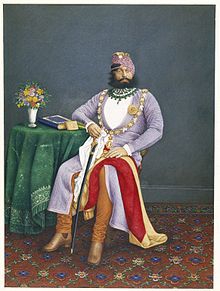Jaswant Singh II
| Jaswant Singh | |
|---|---|
| Maharaja of Jodhpur | |
 Maharaja Jaswant Singh II of Marwar, c. 1880. Attributed to Narsingh. The Brooklyn Museum. | |
| Maharaja of Jodhpur | |
| Tenure | 4 February 1873 – 11 October 1895 |
| Predecessor | Takht Singh |
| Successor | Sardar Singh |
| Born | 1838 Ahmadnagar, Gujarat, India |
| Died | 11 October 1895 (aged 56–57) |
| Spouse | Rajba Kanwar Puariji Bijay Kanwar Nain Raiji Guman Kanwar Roop Kanwar Anand Kanwar 8 others |
| Issue | Raja Tej Singh Raja Sawai Singh Suraj Kanwar Sardar Singh Keshari Singh 5 others |
| House | Rathore-Jodhpur |
| Father | Maharaja Takht of Jodhpur |
| Mother | Maharani Gulab Kanwar, Princess of Sirohi |
| Religion | Hinduism |
Jaswant Singh II, GCSI,[1] (1838 – 11 October 1895)[2][3] was Maharaja of Jodhpur from 4 February 1873 – 11 October 1895.
Birth
He was born in 1838 at Ahmadnagar in Gujarat and was eldest son of Takht Singh and his consort, Maharani Gulab Kanwar, daughter of Maharaja Sheo Singh of Sirohi.[4] He ruled during the time of Aurangzeb.
Marriage
He had eight wives, of which the first was the daughter of the Jam Sahib of Nawanagar, Rajba Kanwar. Puariji Bijay Kanwar was his chief consort and mother of Maharaja Sardar Singh.[5]
Accession
He acceded to the throne of Jodhpur in 1873 upon death of his father, Takht Singh,[4]
Reign

The reign of Jaswant Singh II was marked with remarkable prosperity and reforms and development works. He established Courts of Justice, introduced system of revenue settlement and reorganizing all the state departments.[4] Further, he developed infrastructure of the state by introducing telegraphs, railways (Jodhpur State Railway), and developing roads.[4] He formed Imperial Service Cavalry Corps, which later rendered active service in European War.[4] He was honoured and created the Knight Grand Commander of the Most Exalted Order of the Star of India in 1875.[4][6]
Swami Dayananda incident
Jaswant Singh had invited Swami Dayananda as he was influenced by his ideas. But the tragedy occurred when Dayananda was poisoned on 29 September 1883, when he was the royal guest of Jaswant Singh II, by Dayananda's own cook, who had conspired with a court dancer Nanhi Jaan.[7] The Maharaja was quick to arrange the services of a doctor, but the doctor Ali Mardan Khan gave medicines laced with poison which further deteriorated health of Hrishi Dayanand. Later Maharaja arranged for Swamiji to be sent to Mount Abu upon the advice of Residency.[7]
Death
He died 11 October 1895 and was succeeded by his middle son Sardar Singh. [5]
Jaswant Thada

The Jaswant Thada is an architectural landmark located in Jodhpur. It is a white marble memorial built by Sardar Singh in 1899 in memory of Maharaja Jaswant Singh II.[8]
References
- ^ The Golden Book of India: A Genealogical and Biographical Dictionary of the ... By Sir Roper Lethbridge:pp 218
- ^ Sir William Wilson Hunter, Imperial gazetteer of India, Volume 21, Page 34
- ^ Nirmal Upadhyaya, The administration of Jodhpur State, 1800–1947 A.D.
- ^ a b c d e f Indian States: A Biographical, Historical, and Administrative Survey edited by Arnold Wright, 1922:pp 200.
- ^ a b "Jodhpur". Archived from the original on 4 April 2016. Retrieved 20 December 2013.
- ^ "London Gazette, 31 December 1875". Archived from the original on 24 December 2013. Retrieved 23 December 2013.
- ^ a b World Perspectives on Swami Dayananda Saraswati By Gaṅgā Rām Garg :pp 96–98
- ^ The Indian Encyclopaedia: Indo-Pak War-Kamla Karri by Subodh Kapoor – 2002 – Page 3755 Jasvvant Thada, Close to the fort complex lies this white marble cenotaph, built in 1899, in commemoration of Maharaja Jaswant Singh II. Rare portraits of Jodhpur's rulers are, also, to be seen at Jaswant Thada.
